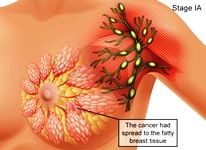Breast Cancer Stages
The most common tool that doctors use to describe the stage is the TNM system. Doctors use the results from diagnostic tests and scans to answer these questions:
Tumor (T): How large is the primary tumor? Where is it located?
Node (N): Has the tumor spread to the lymph nodes? If so, where and how many?
Metastasis (M): Has cancer spread to other parts of the body? If so, where and how much?
The results are combined to determine the stage of cancer for each person.
There are 5 stages: stage 0 (zero), which is non-invasive ductal carcinoma in situ (DCIS), and stages I through IV (1 through 4), which are used for invasive breast cancer. The stage provides a common way of describing cancer, so doctors can work together to plan the best treatments.
Staging can be clinical or pathological. Clinical staging is based on the results of tests done before surgery, which may include physical examinations, mammograms, ultrasound, and MRI scans. Pathologic staging is based on what is found during surgery to remove breast tissue and lymph nodes. The results are usually available several days after surgery. In general, pathological staging provides the most information to determine a patient’s prognosis.
Related Conference of Breast Cancer Stages
10th International Conference on Gynecology and Obstetrics Pathology
7th International Conference on Breast Pathology and Cancer Diagnosis
Breast Cancer Stages Conference Speakers
Recommended Sessions
- Alternative and Complementary Medicine
- Breast Cancer - Clinical Trials
- Breast Cancer - Current Perspective
- Breast Cancer - Screening, Detection and Diagnosis
- Breast Cancer - Therapy, Prevention and Medication
- Breast Cancer and Nursing
- Breast Cancer and Pregnancy
- Breast Cancer Stages
- Breast Cancer: Case Study
- Breast Cancer: Survivorship
- Call for Workshops/Symposia
- Controversies in Breast Cancer
- Current and Future State
- Immunology and Breast Cancer
- Industries and Investors Meet
- Lifestyle and Breast Cancer
- Male Breast Cancer
- Personalized Medicine - A Redefined Treatment
- Surgical Choices for Breast Cancer
Related Journals
Are you interested in
- Adolescent Gynecology - GYNECOLOGY AND OBSTETRICS 2026 (Netherlands)
- Advances in Molecular and Cellular Pathology - PATHOLOGY SUMMIT 2026 (UAE)
- Anatomical Pathology - Pathology 2026 (Japan)
- Breast Health and Diseases - GYNECOLOGY AND OBSTETRICS 2026 (Netherlands)
- Breast Pathology - Pathology 2026 (Japan)
- Cancer Pathology - Pathology 2026 (Japan)
- Cancer Pathology & Biomarkers - Euro Pathology 2026 (France)
- Cancer Pathology & Tumor Biology - World Pathology Conference 2026 (Netherlands)
- Cancer Pathology and Oncology Diagnostics - Pathology Congress-2026 (UAE)
- Cancer Pathology and Tumor Biomarkers - PATHOLOGY SUMMIT 2026 (UAE)
- Cardiovascular Pathology - Pathology Congress-2026 (UAE)
- Cardiovascular Pathology - Euro Pathology 2026 (France)
- Cardiovascular Pathology & Vascular Diseases - World Pathology Conference 2026 (Netherlands)
- Cardiovascular Pathology and Vascular Biology - Pathology 2026 (Japan)
- Clinical Chemistry and Diagnostic Innovations - PATHOLOGY SUMMIT 2026 (UAE)
- Clinical Cytogenetics and Chromosomal Diagnostics - PATHOLOGY SUMMIT 2026 (UAE)
- Clinical Pathology - Pathology 2026 (Japan)
- Clinical Pathology & Laboratory Medicine - World Pathology Conference 2026 (Netherlands)
- Clinical Pathology and Laboratory Medicine - Pathology Congress-2026 (UAE)
- Contraception and Family Planning - GYNECOLOGY AND OBSTETRICS 2026 (Netherlands)
- Cytopathology & Liquid Biopsy Techniques - World Pathology Conference 2026 (Netherlands)
- Cytopathology and Fine Needle Aspiration (FNA) - Pathology Congress-2026 (UAE)
- Cytopathology and Histopathology - Pathology 2026 (Japan)
- Dermatopathology - Pathology 2026 (Japan)
- Dermatopathology & Skin Cancers - Euro Pathology 2026 (France)
- Dermatopathology & Skin Disease Mechanisms - World Pathology Conference 2026 (Netherlands)
- Diagnostic Histopathology & Tissue Analysis - World Pathology Conference 2026 (Netherlands)
- Digital Imaging and Computational Pathology - PATHOLOGY SUMMIT 2026 (UAE)
- Digital Innovations in Laboratory Medicine - Euro Pathology 2026 (France)
- Digital Pathology & AI in Diagnostics - Euro Pathology 2026 (France)
- Digital Pathology & Artificial Intelligence - World Pathology Conference 2026 (Netherlands)
- Digital Pathology and Artificial Intelligence - Pathology Congress-2026 (UAE)
- Digital Pathology and Artificial Intelligence Applications - PATHOLOGY SUMMIT 2026 (UAE)
- Digital Pathology and e-Pathology - Pathology 2026 (Japan)
- Endocrine and Reproductive Pathology - Pathology 2026 (Japan)
- Endocrine Pathology & Metabolic Disorders - World Pathology Conference 2026 (Netherlands)
- Endometriosis and Fibroids - GYNECOLOGY AND OBSTETRICS 2026 (Netherlands)
- Environmental and Occupational Pathology - Pathology Congress-2026 (UAE)
- Ethics and Innovations in Pathology - Pathology Congress-2026 (UAE)
- Forensic Pathology & Medicolegal Investigations - World Pathology Conference 2026 (Netherlands)
- Forensic Pathology and Legal Medicine Insights - PATHOLOGY SUMMIT 2026 (UAE)
- Forensic Pathology and Medical Examinations - Pathology Congress-2026 (UAE)
- Future Trends in Laboratory Medicine and Diagnostics - PATHOLOGY SUMMIT 2026 (UAE)
- Gastrointestinal & Hepatobiliary Pathology - World Pathology Conference 2026 (Netherlands)
- Gastrointestinal & Liver Pathology - Euro Pathology 2026 (France)
- Gastrointestinal and Liver Pathology - Pathology 2026 (Japan)
- Genetics in Gynecology and Obstetrics - GYNECOLOGY AND OBSTETRICS 2026 (Netherlands)
- Genitourinary Pathology & Male Reproductive Health - World Pathology Conference 2026 (Netherlands)
- Genomic Pathology and Personalized Medicine - PATHOLOGY SUMMIT 2026 (UAE)
- Gynecologic Oncology - GYNECOLOGY AND OBSTETRICS 2026 (Netherlands)
- Gynecologic Pathology - GYNECOLOGY AND OBSTETRICS 2026 (Netherlands)
- Gynecologic Surgery - GYNECOLOGY AND OBSTETRICS 2026 (Netherlands)
- Hematopathology - Pathology 2026 (Japan)
- Hematopathology & Blood Disorders - World Pathology Conference 2026 (Netherlands)
- Hematopathology & Bone Marrow Diseases - Euro Pathology 2026 (France)
- Hematopathology and Blood Disorders - Pathology Congress-2026 (UAE)
- Hematopathology and Blood Disorders Diagnostics - PATHOLOGY SUMMIT 2026 (UAE)
- Histopathology and Tissue Engineering - Pathology Congress-2026 (UAE)
- Histopathology Techniques and Tissue Diagnostics - PATHOLOGY SUMMIT 2026 (UAE)
- Imaging in Gynecology and Obstetrics - GYNECOLOGY AND OBSTETRICS 2026 (Netherlands)
- Immunopathology & Autoimmune Diseases - Euro Pathology 2026 (France)
- Immunopathology & Immune-Mediated Diseases - World Pathology Conference 2026 (Netherlands)
- Immunopathology and Autoimmune Disease Markers - PATHOLOGY SUMMIT 2026 (UAE)
- Immunopathology and Autoimmune Diseases - Pathology Congress-2026 (UAE)
- Infectious Disease Pathology - Pathology Congress-2026 (UAE)
- Infectious Disease Pathology & Emerging Pathogens - Euro Pathology 2026 (France)
- Infectious Disease Pathology & Emerging Pathogens - World Pathology Conference 2026 (Netherlands)
- Infectious Disease Pathology and Microbial Testing - PATHOLOGY SUMMIT 2026 (UAE)
- Infectious Diseases in Obstetrics and Gynecology - GYNECOLOGY AND OBSTETRICS 2026 (Netherlands)
- Laboratory Quality Management & Accreditation - World Pathology Conference 2026 (Netherlands)
- Liver and Gastrointestinal Pathology - Pathology Congress-2026 (UAE)
- Maternal-Fetal Medicine - GYNECOLOGY AND OBSTETRICS 2026 (Netherlands)
- Menopause and Hormone Replacement Therapy - GYNECOLOGY AND OBSTETRICS 2026 (Netherlands)
- Microbial Pathology - Pathology 2026 (Japan)
- Minimally Invasive Gynecologic Surgery - GYNECOLOGY AND OBSTETRICS 2026 (Netherlands)
- Molecular Pathology - Pathology 2026 (Japan)
- Molecular Pathology & Genomic Medicine - World Pathology Conference 2026 (Netherlands)
- Molecular Pathology & Genomics - Euro Pathology 2026 (France)
- Molecular Pathology and Genomics - Pathology Congress-2026 (UAE)
- Neuropathology & Neurodegenerative Disorders - Euro Pathology 2026 (France)
- Neuropathology & Neurodegenerative Disorders - World Pathology Conference 2026 (Netherlands)
- Neuropathology and Central Nervous System Disorders - PATHOLOGY SUMMIT 2026 (UAE)
- Neuropathology and Neurodegenerative Disorders - Pathology Congress-2026 (UAE)
- Neuropathology and Neurodegenerative Disorders - Pathology 2026 (Japan)
- Obstetric Anesthesia - GYNECOLOGY AND OBSTETRICS 2026 (Netherlands)
- Oral & Maxillofacial Pathology - World Pathology Conference 2026 (Netherlands)
- Oral and Maxillofacial Pathology - Pathology 2026 (Japan)
- Pathology Education, Training & Skill Development - World Pathology Conference 2026 (Netherlands)
- Pathology Informatics & Data Science - World Pathology Conference 2026 (Netherlands)
- Pathology Informatics and Data Management - Pathology Congress-2026 (UAE)
- Pathology Informatics and Laboratory Data Systems - PATHOLOGY SUMMIT 2026 (UAE)
- Patient Safety and Quality in Gynecology and Obstetrics - GYNECOLOGY AND OBSTETRICS 2026 (Netherlands)
- Pediatric & Developmental Pathology - Euro Pathology 2026 (France)
- Pediatric and Developmental Pathology Advances - PATHOLOGY SUMMIT 2026 (UAE)
- Pediatric and Perinatal Pathology - Pathology 2026 (Japan)
- Pediatric Pathology - Pathology Congress-2026 (UAE)
- Pediatric Pathology & Developmental Disorders - World Pathology Conference 2026 (Netherlands)
- Perinatal and Neonatal Care - GYNECOLOGY AND OBSTETRICS 2026 (Netherlands)
- Point-of-Care Testing and Rapid Diagnostics - PATHOLOGY SUMMIT 2026 (UAE)
- Precision Medicine & Targeted Therapies - Euro Pathology 2026 (France)
- Prenatal Diagnosis and Screening - GYNECOLOGY AND OBSTETRICS 2026 (Netherlands)
- Pulmonary & Thoracic Pathology - Euro Pathology 2026 (France)
- Pulmonary and Thoracic Pathology - Pathology 2026 (Japan)
- Pulmonary Pathology & Respiratory Disorders - World Pathology Conference 2026 (Netherlands)
- Quality Control and Standardization in Labs - PATHOLOGY SUMMIT 2026 (UAE)
- Renal Pathology - Pathology Congress-2026 (UAE)
- Renal Pathology - Pathology 2026 (Japan)
- Renal Pathology & Kidney Disorders - World Pathology Conference 2026 (Netherlands)
- Renal Pathology & Transplantation - Euro Pathology 2026 (France)
- Reproductive Endocrinology and Infertility - GYNECOLOGY AND OBSTETRICS 2026 (Netherlands)
- Reproductive Pathology & Women’s Health - World Pathology Conference 2026 (Netherlands)
- Sexual and Reproductive Health - GYNECOLOGY AND OBSTETRICS 2026 (Netherlands)
- Surgical Pathology - Pathology 2026 (Japan)
- Toxicologic Pathology and Environmental Testing - PATHOLOGY SUMMIT 2026 (UAE)
- Translational Pathology & Biomarker Discovery - World Pathology Conference 2026 (Netherlands)
- Translational Pathology and Biomarkers - Pathology Congress-2026 (UAE)
- Translational Pathology: Bridging Research and Practice - PATHOLOGY SUMMIT 2026 (UAE)
- Urogynecology and Pelvic Floor Disorders - GYNECOLOGY AND OBSTETRICS 2026 (Netherlands)
- Veterinary Pathology - Pathology Congress-2026 (UAE)
- Veterinary Pathology - Euro Pathology 2026 (France)
- Veterinary Pathology - Pathology 2026 (Japan)
- Veterinary Pathology & Comparative Medicine - World Pathology Conference 2026 (Netherlands)
- Women’s Health & Gynecologic Pathology - Euro Pathology 2026 (France)


